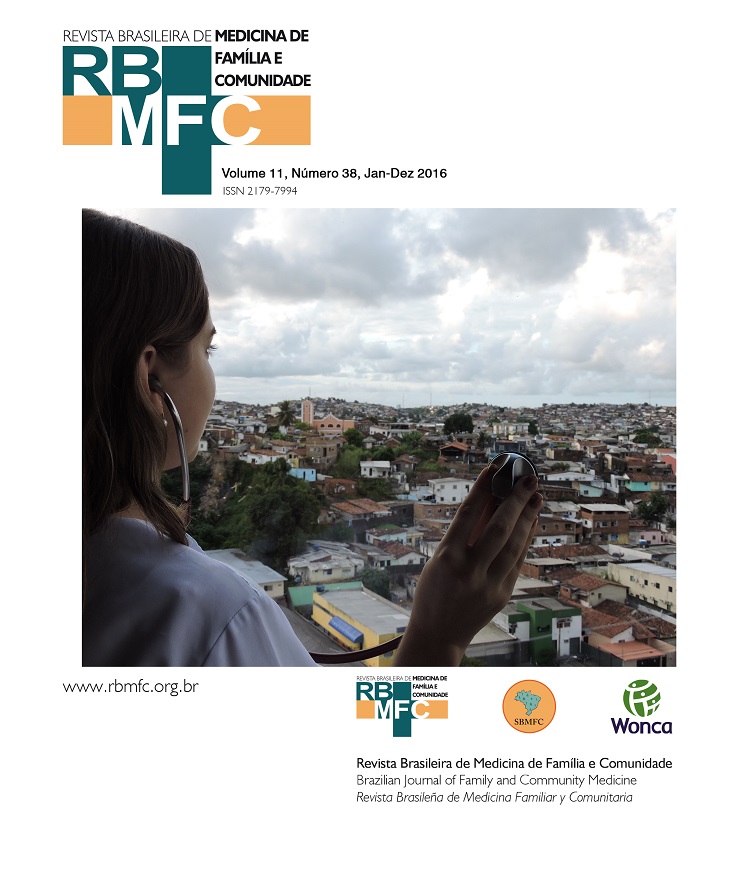Como se estuda o que não se diz: uma revisão sobre demanda oculta
DOI:
https://doi.org/10.5712/rbmfc11(38)1250Palavras-chave:
Relação Médico-Paciente. Comunicação. Necessidades e Demandas de Serviços de Saúde. Atenção Primária à Saúde.Resumo
Objetivos: Pessoas com demandas aparentemente bem delimitadas podem, muitas vezes, ter queixas ou preocupações ocultas ou tardiamente apresentadas, chamadas em inglês de hidden agenda, by the way syndrome ou doorknob syndrome (“síndrome da maçaneta”). Poucos trabalhos abordam o fenômeno em contexto clínico discutindo seus aspectos ou consequências sobre o cuidado do ponto de vista sociocultural. Uma pesquisa qualitativa sobre saúde dos homens realizada pelos autores exigiu estudar a produção científica relacionada à hidden agenda de forma descritiva e interpretativa. Métodos: Esta revisão, do tipo estado da questão, abarcou artigos que tratassem da hidden agenda (ou expressões similares) no contexto clínico geral ou especializado, médico ou multiprofissional, em português, inglês ou espanhol, no período de 2000 a 2014. Partindo de 210 resultados iniciais em 3 bases de dados internacionais, foram selecionadas 39 publicações, que foram avaliadas quanto a características objetivas e subjetivas. Resultados: Identificando os temas predominantes nas pesquisas, notamos que hidden agenda é a expressão mais específica, sendo demanda oculta sua melhor tradução. Quase todos os estudos relacionavam a atenção a demandas ocultas a melhores desfechos ou desdobramentos do atendimento, embora nenhum avaliasse essas consequências de forma aprofundada. Conclusão: A revisão deixa claro que a demanda oculta é um elemento problematizador para pensar a prática médica e potencializador para a clínica, especialmente ao buscar-se um cuidado integral e um diálogo efetivo entre profissional e usuário(a). São necessários estudos que articulem o fenômeno a aspectos socioculturais ou tecnoassistenciais e que contemplem alguma discussão sobre construção da demanda, ausente nos artigos revisados.
Downloads
Métricas
Referências
Menahem S. Teaching students of medicine to listen: the missed diagnosis from a hidden agenda. J R Soc Med. 1987;80(6):343-6. DOI: https://doi.org/10.1177/014107688708000606
Silverman J. Hidden agendas and how to uncover them. Medicine. 2005;33(2):27-9. DOI: http://dx.doi.org/10.1383/medc.33.2.27.58375 DOI: https://doi.org/10.1383/medc.33.2.27.58375
Barsky AJ 3rd. Hidden reasons some patients visit doctors. Ann Intern Med. 1981;94(4 pt 1):492-8. DOI: http://dx.doi.org/10.7326/0003-4819-94-4-492 DOI: https://doi.org/10.7326/0003-4819-94-4-492
Beckman HB, Frankel RM. The effect of physician behavior on the collection of data. Ann Intern Med. 1984;101(5):692-6. DOI: http://dx.doi.org/10.7326/0003-4819-101-5-692 DOI: https://doi.org/10.7326/0003-4819-101-5-692
Hengstler P, Battegay E, Cornuz J, Bucher H, Battegay M. Evidence for prevention and screening: recommendations in adults. Swiss Med Wkly. 2002;132(27-28):363-73. PMID: 12428190
Ahmad K, Ramsay B. Patients’ fears and expectations: exploring the hidden agenda in our consultation. Arch Dermatol. 2009;145(6):722-3. PMID: 19528436 DOI: http://dx.doi.org/10.1001/archdermatol.2009.102 DOI: https://doi.org/10.1001/archdermatol.2009.102
Marvel MK, Epstein RM, Flowers K, Beckman HB. Soliciting the patient’s agenda: have we improved? JAMA. 1999;281(3):283-7. DOI: http://dx.doi.org/10.1001/jama.281.3.283 DOI: https://doi.org/10.1001/jama.281.3.283
Barry CA, Bradley CP, Britten N, Stevenson FA, Barber N. Patients’ unvoiced agendas in general practice consultations: qualitative study. BMJ. 2000;320(7244):1246-50. DOI: http://dx.doi.org/10.1136/bmj.320.7244.1246 DOI: https://doi.org/10.1136/bmj.320.7244.1246
Jackson G. “Oh ... by the way ... “: doorknob syndrome. Int J Clin Pract. 2005;59(8):869. DOI: http://dx.doi.org/10.1111/j.1368-5031.2005.0599a.x DOI: https://doi.org/10.1111/j.1368-5031.2005.0599a.x
Rodondi PY, Maillefer J, Suardi F, Rodondi N, Cornuz J, Vannotti M. Physician response to “by-the-way” syndrome in primary care. J Gen Intern Med. 2009;24(6):739-41. DOI: http://dx.doi.org/10.1007/s11606-009-0980-2 DOI: https://doi.org/10.1007/s11606-009-0980-2
Stewart M, Brown JB, Donner A, McWhinney IR, Oates J, Weston WW, et al. The impact of patient-centered care on outcomes. J Fam Pract. 2000;49(9):796-804. PMID:11032203
Starfield B. Atenção Primária: equilíbrio entre necessidades de saúde, serviços e tecnologia. Brasília: UNESCO/Ministério da Saúde; 2002. p.726.
Ieto V, Cunha MC. Queixa, demanda e desejo na clínica fonoaudiológica: um estudo de caso clínico. Rev Soc Bras Fonoaudiol. 2007;12(4):329-34. DOI: http://dx.doi.org/10.1590/S1516-80342007000400013 DOI: https://doi.org/10.1590/S1516-80342007000400013
Echeverri Gallo C, Alvarez Restrepo A, Londono Bernal LV. Aspectos subjetivos implicados en la demanda de consulta médica frecuente. Psicol Caribe. 2012;29(2):511-37.
Ribeiro MMF, Amaral CFS. Medicina centrada no paciente e ensino médico: a importância do cuidado com a pessoa e o poder médico. Rev Bras Educ Med. 2008;32(1):90-7. DOI: http://dx.doi.org/10.1590/S0100-55022008000100012 DOI: https://doi.org/10.1590/S0100-55022008000100012
Leite AJM, Caparara A, Coelho Filho JM, orgs. Habilidades de comunicação com pacientes e famílias. São Paulo: Sarvier; 2007.
Nóbrega-Therrien SM, Therrien J. Trabalhos científicos e o estado da questão: reflexões teórico-metodológicas. Estud Aval Educ. 2004;15(30):5-16. DOI: http://dx.doi.org/10.18222/eae153020042148 DOI: https://doi.org/10.18222/eae153020042148
Cavalcante Neto PG, Lira GV, Miranda AS. Interesse dos estudantes pela medicina de família: estado da questão e agenda de pesquisa. Rev Bras Educ Med. 2009;33(2):198-204. DOI: http://dx.doi.org/10.1590/S0100-55022009000200006 DOI: https://doi.org/10.1590/S0100-55022009000200006
Minayo MCS. O desafio do conhecimento: pesquisa qualitativa em saúde. 2a ed. São Paulo/Rio de Janeiro: Hucitec/Abrasco; 1993.
Pernia A, Torres LM, Calderón E. Tratamiento del dolor postoperatorio mediante analgesia intravenosa controlada por el paciente (P C A i. v.). Comparación entre propacetamol y metamizol. Rev Soc Esp Dolor. 2000;7(6):354-60.
Oliveira RM, Tenório SB, Tanaka PP, Precoma D. Controle da dor por bloqueio peridural e incidência de disritmias cardíacas no pós-operatório de procedimentos cirúrgicos torácicos e abdominais altos: estudo comparativo. Rev Bras Anestesiol. 2012;62(1):14-8. DOI: http://dx.doi.org/10.1590/S0034-
Guix J. Analizando los “porqués”: los grupos focales. Rev Calid Asist. 2003;18(7):598-602. DOI: http://dx.doi.org/10.1016/S1134-282X(03)77644-1 DOI: https://doi.org/10.1016/S1134-282X(03)77644-1
Penson DF. The hidden agenda in the release of the Medicare physician reimbursement data. Urology. 2014;84(3):501-2. DOI: http://dx.doi.org/10.1016/j.urology.2014.06.001 DOI: https://doi.org/10.1016/j.urology.2014.06.001
Tesfay F. AIDS/HIV pandemic: the hidden agenda. J Natl Med Assoc. 2001;93(11):446-8. PMID: 11730119
Santos-Padrón H, Martínez-Calvo S, Martínez-López MC, Álvarez-Malpica IL. La demanda potencial y la oferta de servicios de salud para las enfermedades catastróficas en México. Rev Gerenc Polit Salud. 2011;10(21):33-47.
Diana M, Song T, Wittkowski KM. Studying travel-related individual assessments and desires by combining hierarchically structured ordinal variables. Transportation (Amst). 2009;36(2):187-206. DOI: http://dx.doi.org/10.1007/s11116-009-9186-z DOI: https://doi.org/10.1007/s11116-009-9186-z
Vásquez WF, Mozumder P, Hernández-Arce J, Berrens RP. Willingness to pay for safe drinking water: Evidence from Parral, Mexico. J Environ Manage. 2009;90(11):3391-400. DOI: http://dx.doi.org/10.1016/j.jenvman.2009.05.009 DOI: https://doi.org/10.1016/j.jenvman.2009.05.009
Cover JK, Drake JK, Kyamwanga IT, Turyakira E, Dargan T, Kumakech E, et al. Consumer perspectives on a pericoital contraceptive pill in India and Uganda. Int Perspect Sex Reprod Health. 2013;39(4):195-204. DOI: http://dx.doi.org/10.1363/3919513 DOI: https://doi.org/10.1363/3919513
Stonebraker JS, Farrugia A, Gathmann B; ESID Registry Working Party, Orange JS. Modeling primary immunodeficiency disease epidemiology and its treatment to estimate latent therapeutic demand for immunoglobulin. J Clin Immunol. 2014;34(2):233-44. DOI: http://dx.doi.org/10.1007/s10875-013-9975-
DOI: http://dx.doi.org/10.1007/s10875-013-9975-1 DOI: https://doi.org/10.1007/s10875-013-9975-1
Snoek FJ, Kersch NY, Eldrup E, Harman-Boehm I, Hermanns N, Kokoszka A, et al. Monitoring of Individual Needs in Diabetes (MIND): baseline data from the Cross-National Diabetes Attitudes, Wishes, and Needs (DAWN) MIND study. Diabetes Care. 2011;34(3):601-3. DOI: http://dx.doi.org/10.2337/dc10-1552 DOI: https://doi.org/10.2337/dc10-1552
Snoek FJ, Kersch NY, Eldrup E, Harman-Boehm I, Hermanns N, Kokoszka A, et al. Monitoring of Individual Needs in Diabetes (MIND)-2: follow-up data from the cross-national Diabetes Attitudes, Wishes, and Needs (DAWN) MIND study. Diabetes Care. 2012;35(11):2128-32. DOI: http://dx.doi.org/10.2337/dc11-1326 DOI: https://doi.org/10.2337/dc11-1326
Rhodes P, Langdon M, Rowley E, Wright J, Small N. What does the use of a computerized checklist mean for patient-centered care? The example of a routine diabetes review. Qual Health Res. 2006;16(3):353-76. DOI: http://dx.doi.org/10.1177/1049732305282396 DOI: https://doi.org/10.1177/1049732305282396
Makoul G, Curry RH, Tang PC. The use of electronic medical records: communication patterns in outpatient encounters. J Am Med Inform Assoc. 2001;8(6):610-5. DOI: http://dx.doi.org/10.1136/jamia.2001.0080610 DOI: https://doi.org/10.1136/jamia.2001.0080610
Meeuwesen L, Bensing J, van den Brink-Muinen A. Communicating fatigue in general practice and the role of gender. Patient Educ Couns. 2002;48(3):233-42. DOI: http://dx.doi.org/10.1016/S0738-3991(02)00176-3 DOI: https://doi.org/10.1016/S0738-3991(02)00176-3
Jones MP. Evaluation and treatment of dyspepsia. Postgrad Med J. 2003;79(927):25-9. DOI: http://dx.doi.org/10.1136/pmj.79.927.25 DOI: https://doi.org/10.1136/pmj.79.927.25
Sepucha KR, Belkora JK, Mutchnick S, Esserman LJ. Consultation planning to help breast cancer patients prepare for medical consultations: effect on communication and satisfaction for patients and physicians. J Clin Oncol. 2002;20(11):2695-700. DOI: http://dx.doi.org/10.1200/JCO.2002.10.068 DOI: https://doi.org/10.1200/JCO.2002.10.068
Bower P, Macdonald W, Harkness E, Gask L, Kendrick T, Valderas JM, et al. Multimorbidity, service organization and clinical decision making in primary care: a qualitative study. Fam Pract. 2011;28(5):579-87. DOI: http://dx.doi.org/10.1093/fampra/cmr018 DOI: https://doi.org/10.1093/fampra/cmr018
Frich JC, Malterud K, Fugelli P. Women at risk of coronary heart disease experience barriers to diagnosis and treatment: a qualitative interview study. Scand J Prim Health Care. 2006;24(1):38-43. DOI: http://dx.doi.org/10.1080/02813430500504305 DOI: https://doi.org/10.1080/02813430500504305
Hazzard A, Harris W, Howell D. Taking care: practice and philosophy of communication in a critical care follow-up clinic. Intensive Crit Care Nurs. 2013;29(3):158-65. DOI: http://dx.doi.org/10.1016/j.iccn.2013.01.003 DOI: https://doi.org/10.1016/j.iccn.2013.01.003
Sussman AL, Williams RL, Leverence R, Gloyd PW Jr, Crabtree BF. The art and complexity of primary care clinicians’ preventive counseling decisions: obesity as a case study. Ann Fam Med. 2006;4(4):327-33. DOI: http://dx.doi.org/10.1370/afm.566 DOI: https://doi.org/10.1370/afm.566
Dyche L, Swiderski D. The effect of physician solicitation approaches on ability to identify patient concerns. J Gen Intern Med. 2005;20(3):267-70. DOI: http://dx.doi.org/10.1111/j.1525-1497.2005.40266.x DOI: https://doi.org/10.1111/j.1525-1497.2005.40266.x
Huffman MH. Compliance, health outcomes, and partnering in PPS: acknowledging the patient’s agenda. Home Healthc Nurse. 2005;23(1):23-8.
Weiss MC, Platt J, Riley R, Taylor G, Horrocks S, Taylor A. Solicitations in GP, nurse and pharmacist prescriber consultations: an observational study. Fam Pract. 2013;30(6):712-8. DOI: http://dx.doi.org/10.1093/fampra/cmt042 DOI: https://doi.org/10.1093/fampra/cmt042
Vegni E, Martinoli M, Moja EA. Improving patient-centred medicine: a preliminary experience for teaching communication skills to Italian general practitioners. Educ Health (Abingdon). 2002;15(1):51-7. DOI: http://dx.doi.org/10.1080/13576280110107314 DOI: https://doi.org/10.1080/13576280110107314
Altiner A, Schäfer I, Mellert C, Löffler C, Mortsiefer A, Ernst A, et al. Activating GENeral practitioners dialogue with patients on their Agenda (MultiCare AGENDA) study protocol for a cluster randomized controlled trial. BMC Fam Pract. 2012;13:118. DOI: http://dx.doi.org/10.1186/1471-2296-13-118 DOI: https://doi.org/10.1186/1471-2296-13-118
Kasje WN, Timmer JW, Boendermaker PM, Haaijer-Ruskamp FM. Dutch GPs’ perceptions: the influence of out-of-pocket costs on prescribing. Soc Sci Med. 2002;55(9):1571-8. DOI: http://dx.doi.org/10.1016/S0277-9536(01)00291-X DOI: https://doi.org/10.1016/S0277-9536(01)00291-X
Jacquemyn Y, Ahankour F, Martens G. Flemish obstetricians’ personal preference regarding mode of delivery and attitude towards caesarean section on demand. Eur J Obstet Gynecol Reprod Biol. 2003;111(2):164-6. DOI: http://dx.doi.org/10.1016/S0301
Bremberg S, Nilstun T. Justifications of physicians’ choice of action. Scand J Prim Health Care. 2005;23(2):102-8. DOI: http://dx.doi.org/10.1080/02813430510018455
Cahana A, Weibel H, Hurst SA. Ethical decision-making: do anesthesiologists, surgeons, nurse anesthetists, and surgical nurses reason similarly? Pain Med. 2008;9(6):728-36. DOI: http://dx.doi.org/10.1080/02813430510018455. DOI: https://doi.org/10.1080/02813430510018455
Ordonez Fernandez MP. Psicoterapia de Apoyo en Atención Primaria. Rev Clin Med Fam. 2008;2(5):226-35. DOI: http://dx.doi.org/10.4321/S1699-695X2008000300006 DOI: https://doi.org/10.4321/S1699-695X2008000300006
Hunt O, McCurley N, Dempster M, Marley J. Patient anxiety and IV sedation in Northern Ireland. Br Dent J. 2011;210(12):575-9. DOI: http://dx.doi.org/10.1038/sj.bdj.2011.483 DOI: https://doi.org/10.1038/sj.bdj.2011.483
Aulakh RS, Melsen B. When should orthodontics be part of reconstruction of a degenerating dentition? A case report. Prog Orthod. 2011;12(2):161-8. DOI: http://dx.doi.org/10.1016/j.pio.2011.06.006 DOI: https://doi.org/10.1016/j.pio.2011.06.006
Kitzinger HB, Abayev S, Pittermann A, Karle B, Kubiena H, Bohdjalian A, et al. The prevalence of body contouring surgery after gastric bypass surgery. Obes Surg. 2012;22(1):8-12. DOI: http://dx.doi.org/10.1007/s11695-011-0459-1 DOI: https://doi.org/10.1007/s11695-011-0459-1
Desplenter FA, Laekeman GJ, De Coster S; VZA Psychiatry Research Group, Simoens SR. Information on antidepressants for psychiatric inpatients: the divide between patient needs and professional practice. Pharm Pract (Granada). 2013;11(2):81-9. DOI: http://dx.doi.org/10.4321/S1886-36552013000200004 DOI: https://doi.org/10.4321/S1886-36552013000200004
Costa FS, Bandeira DR, Trentini C, Brilmann M, Friedman R, Nunes MA. Considerações acerca da avaliação psicológica das comorbidades psiquiátricas em obesos. Psicol Est. 2009;14(2):287-93. DOI: http://dx.doi.org/10.1590/S1413-73722009000200009 DOI: https://doi.org/10.1590/S1413-73722009000200009
Miranda Hiriart G, Saffie Gatica X. Pacientes policonsultantes: ¿un síntoma del sistema de salud en Chile? Acta Bioeth. 2014;20(2):215-23. DOI: http://dx.doi.org/10.4067/S1726-569X2014000200009 DOI: https://doi.org/10.4067/S1726-569X2014000200009
Nakai K, Yamamoto N, Kamei M, Fujita M. The effect of one-dose package on medication adherence for the elderly care in Japan. Pharm Pract (Granada). 2009;7(1):59-62. DOI: http://dx.doi.org/10.4321/S1886-36552009000100009 DOI: https://doi.org/10.4321/S1886-36552009000100009
Burkey JM, Berenholz LP, Lippy WH; Lippy Group. Latent demand for the bone-anchored hearing aid: the Lippy Group experience. Otol Neurotol. 2006;27(5):648-52. DOI: http://dx.doi.org/10.1097/01.mao.0000224086.15968.0d DOI: https://doi.org/10.1097/01.mao.0000224086.15968.0d
Packel L, Keller A, Dow WH, de Walque D, Nathan R, Mtenga S. Evolving strategies, opportunistic implementation: HIV risk reduction in Tanzania in the context of an incentive-based HIV prevention intervention. PLoS One. 2012;7(8):e44058. DOI: http://dx.doi.org/10.1371/journal.pone.0044058 DOI: https://doi.org/10.1371/journal.pone.0044058
Gross R, McNeill R, Davis P, Lay-Yee R, Jatrana S, Crampton P. The association of gender concordance and primary care physicians’ perceptions of their patients. Women Health. 2008;48(2):123-44. DOI: http://dx.doi.org/10.1080/03630240802313464 DOI: https://doi.org/10.1080/03630240802313464
Fallon D, Warne T, McAndrew S, McLaughlin H. An adult education: learning and understanding what young service users and carers really, really want in terms of their mental well being. Nurse Educ Today. 2012;32(2):128-32. DOI: http://dx.doi.org/10.1016/j.nedt.2011.06.002 DOI: https://doi.org/10.1016/j.nedt.2011.06.002
Tempark T, Shwayder T. Chinese fortune-telling based on face and body mole positions: a hidden agenda regarding mole removal. Arch Dermatol. 2012;148(6):772-3. DOI: http://dx.doi.org/10.1001/archdermatol.2012.949 DOI: https://doi.org/10.1001/archdermatol.2012.949
McLeod ME. The caring physician: a journey in self-exploration and self-care. Am J Gastroenterol. 2003;98(10):2135-8. PMID: 14572557 DOI: http://dx.doi.org/10.1111/j.1572-0241.2003.07719.x DOI: https://doi.org/10.1111/j.1572-0241.2003.07719.x
Towersey L, Sinclair J. Collins Cobuild student’s dictionary: bridge bilingual Portuguese. London: Harper Collins Publishers; 1995.
Courtenay WH. Constructions of masculinity and their influence on men’s well-being: a theory of gender and health. Soc Sci Med. 2000;50(10):1385-401. DOI: http://dx.doi.org/10.1016/S0277-9536(99)00390-1 DOI: https://doi.org/10.1016/S0277-9536(99)00390-1
Norman AH, Tesser CD. Prevenção quaternária na atenção primária à saúde: uma necessidade do Sistema Único de Saúde. Cad Saúde Pública. 2009;25(9):2012-20. DOI: http://dx.doi.org/10.1590/S0102-311X2009000900015 DOI: https://doi.org/10.1590/S0102-311X2009000900015
Gusso G, Poli Neto P. Gestão da Clínica. In: Gusso G, Lopes JMC, orgs. Tratado de medicina de família e comunidade: princípios, formação e prática. Porto Alegre: Artmed; 2012. p.159-66.
Schraiber LB, Mendes-Gonçalves RB. Necessidades de saúde e atenção primária. In: Schraiber LB, Nemes MIB, Mendes-Gonçalves RB, orgs. Saúde do adulto: programas e ações na unidade básica. 2a ed. São Paulo: HUCITEC; 2000. p.29-47.
Rocha F. Algumas considerações sobre as entrevistas preliminares, demanda e início de análise. Percurso. 1991;3(5/6):15-21.
Downloads
Publicado
Como Citar
Edição
Seção
Licença
Ao submeterem um manuscrito à RBMFC, os autores mantêm a titularidade dos direitos autorais sobre o artigo, e autorizam a RBMFC a publicar esse manuscrito sob a licença Creative Commons Atribuição 4.0 e identificar-se como veículo de sua publicação original.














